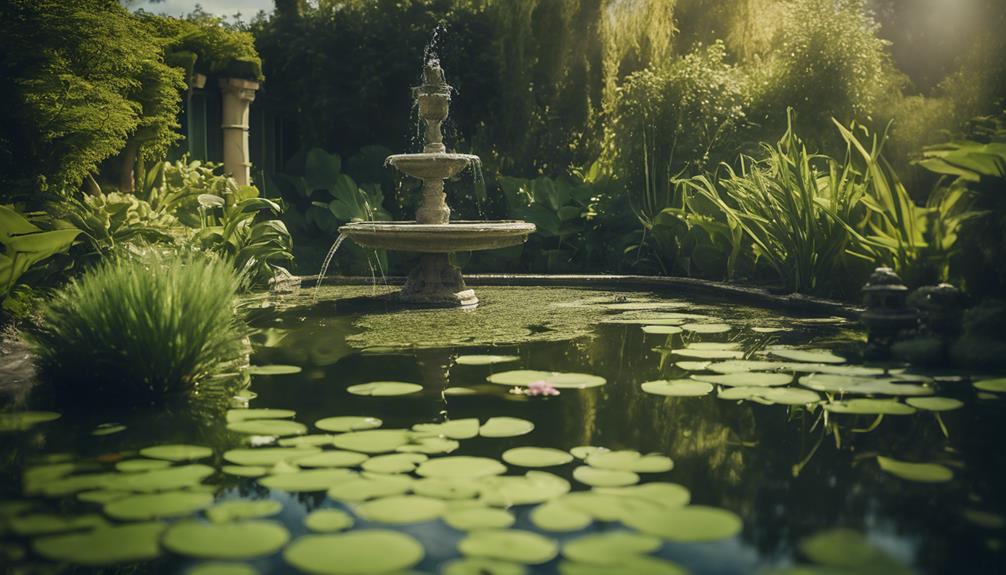You notice a thick, green scum coating the surface of your small garden pond, it's likely due to an overabundance of nutrients, such as nitrogen and phosphorus, that have triggered an explosion of algae growth. These excess nutrients can come from fertilizer applications, runoff from surrounding fields, and improper pond maintenance. Direct sunlight and low water temperatures can also contribute to algae growth. Identifying the type of algae affecting your pond is vital to take the appropriate measures to control its growth. As you explore the reasons behind algae growth, you'll uncover the keys to maintaining a balanced ecosystem and preventing its excessive proliferation.
Table of Contents
Key Takeaways
- Excess nutrients, such as nitrogen and phosphorus, entering the pond through fertilizer applications, runoff, or improper maintenance trigger algae growth.
- Low water temperatures prevent aquatic plants and fish from becoming active, allowing algae to thrive and dominate the ecosystem.
- Direct sunlight provides the necessary energy for single-celled algae to grow and reproduce rapidly, leading to excessive growth.
- Improper pond maintenance, including infrequent water changes and inadequate aeration, contributes to an accumulation of excess nutrients, promoting algae growth.
- Fertilizer applications and runoff from surrounding fields can introduce excess nutrients into the pond, fueling algae growth and potential blooms.
Understanding Algae Basics
Understanding is pivotal to grasp the fundamental principles of algae growth, recognizing that these simple aquatic plants can be both beneficial and detrimental to the ecosystem.
Algae often play a key role in your pond's food chain, providing sustenance for species at the lower end of the chain. However, their excessive growth can have devastating effects, such as depleting oxygen levels and harming fish populations.
As a pond owner, it's imperative to acknowledge that algae growth occurs when excess nutrients, like nitrogen and phosphorus, enter the pond.
This can happen through various means, including fertilizer applications, runoff from surrounding fields, and improper pond maintenance.
By understanding these basics, you'll be better equipped to strike a balance between allowing beneficial algae growth and preventing its excessive proliferation.
Causes of Excessive Algae Growth
When excess nutrients accumulate in your pond, they can trigger a chain reaction of events that ultimately lead to excessive algae growth, a scenario that can have far-reaching consequences for the entire ecosystem. As a pond owner, knowing the underlying reasons for this issue is vital to take corrective action.
| Cause | Effect |
|---|---|
| Excess nutrients | Algae blooms, filamentous algae growth |
| Low water temperatures | Inactive aquatic plants and fish, allowing algae to thrive |
| Direct sunlight | Rapid growth and reproduction of single-celled algae |
Low water temperatures can prevent aquatic plants and fish from becoming active, allowing algae to thrive and causing an imbalance in the pond ecosystem. Direct sunlight provides the necessary energy for single-celled algae to grow and reproduce rapidly. Maintaining a delicate balance in your pond's ecosystem is vital to prevent these issues. By understanding the underlying reasons of excessive algae growth, you can take steps to prevent it and create a healthy environment for your aquatic plants and fish to thrive.
Types of Algae in Ponds
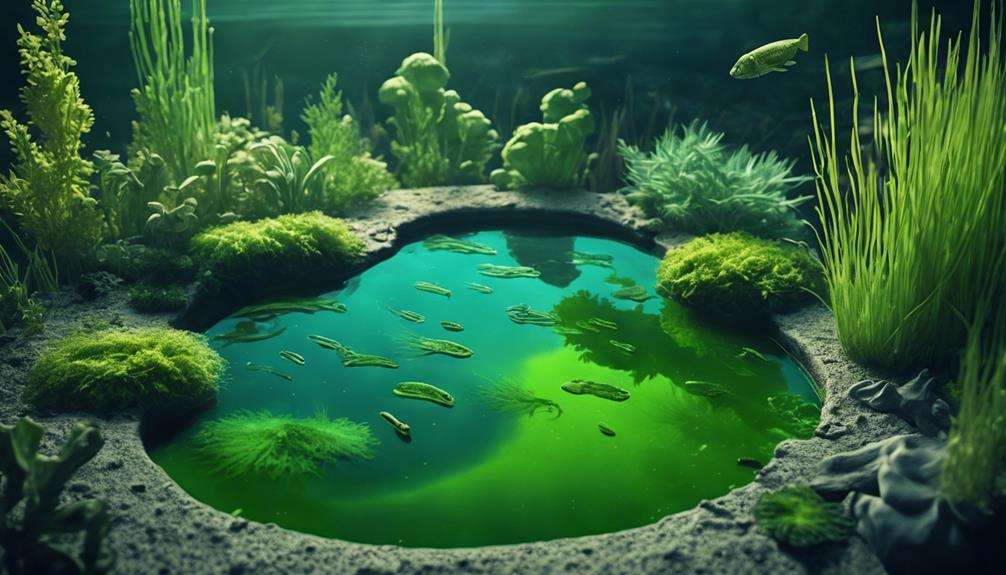
You're likely familiar with the unsightly consequences of excessive algae growth, but did you know that there are several types of algae that can affect your pond's ecosystem?
There are three main types of algae: filamentous, planktonic, and blue-green, each with unique characteristics and growth patterns.
Filamentous algae, also known as string algae, are multi-cellular and need clear, mineral-enriched waters with good light penetration to germinate, often forming mats or strings.
Planktonic algae, on the other hand, are single-celled, mobile, and prefer organic, enriched turbid waters, often causing green or cloudy water.
Blue-green algae, also known as cyanophyte bacteria, can fix their own nitrogen and rely on phosphates, and can produce toxins that can poison wildlife.
Crucial to identify the type of algae affecting your pond is to take the appropriate measures to control its growth.
Preventing Algae Blooms Naturally
Your small garden pond's ecosystem can be protected from the unsightly consequences of algae blooms by adopting natural prevention methods that target the root causes of excessive growth.
By adding aquatic plants, you can absorb excess nutrients, limiting the fuel for algae growth. Shading 40-60% of the pond's surface area with plants also blocks sunlight, reducing the likelihood of algae blooms. Another natural approach is to use barley straw, extract, or pellets, which are safe and effective in preventing algae growth.
Beneficial bacteria, such as those found in Natures Defense and Muck Defense, can also be introduced to your pond ecosystem. These microorganisms consume nutrients and organic material, preventing algae blooms.
Regular pond cleaning and maintenance are also vital in preventing algae growth. By removing excess nutrients and waste, you can create a balanced pond ecosystem where algae can't thrive.
Chemical Algae Treatment Options
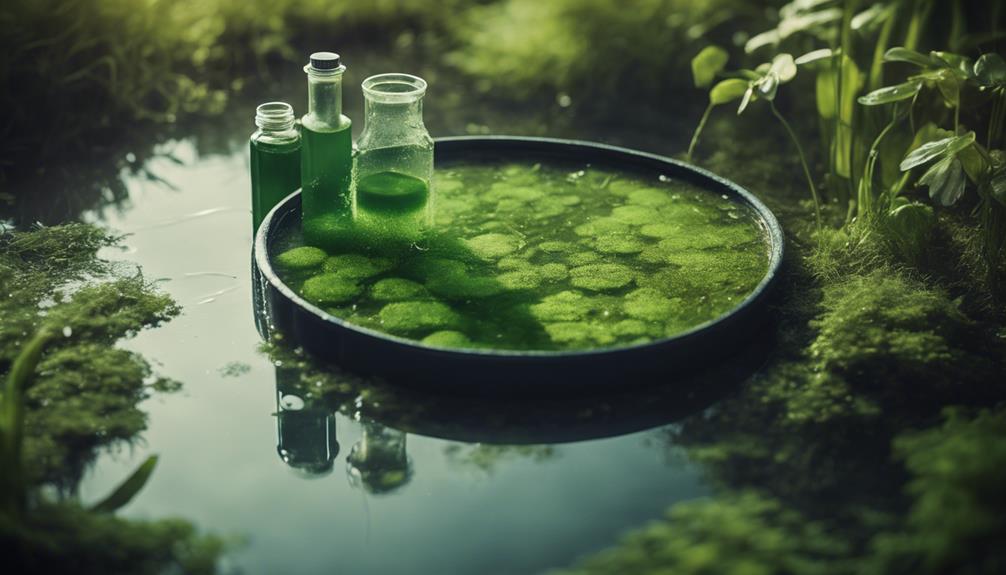
Effective management of algae growth in small garden ponds often requires a multi-faceted approach, and chemical treatment options can provide a quick solution to alleviate the immediate problem.
When dealing with fine planktonic algae that causes green water, you can use liquid chemicals like Algae D-Solv. For filamentous (string) algae growth, granular forms like AlgaeOff are more effective.
Identifying the type of algae you're treating is crucial, as chemical treatments depend on the algae type. Remember, chemical treatments can quickly kill algae, but they require caution to avoid harming fish or other aquatic life.
Always follow the manufacturer's instructions to guarantee safe use. Chemical treatments should be combined with good pond maintenance practices, such as regular water changes and aeration, to prevent algae growth in the long term.
Physical Algae Removal Methods
When it comes to physically removing algae from your small pond, you'll want to ponder the most effective methods for your specific situation.
You'll need to decide whether to use hand removal methods, algae netting tools, or string algae scissors to tackle the problem.
Hand Removal Methods
By manually removing algae from small ponds, you can effectively control its growth and prevent it from dominating the aquatic ecosystem.
Hand removal methods are a simple yet efficient way to get rid of excess Pond Algae. When cleaning your pond, it's vital to Remove the excess algae to maintain a balanced ecosystem.
Start by scooping out visible algae blooms from the pond's surface using your hands or a small skimmer. Be sure to wear gloves to protect yourself from any potential irritants.
Next, target areas with dense algae growth, gently pulling it away from the pond's floor or walls. Avoid disturbing the sediment, as this can stir up more nutrients and promote further algae growth.
By regularly practicing hand removal methods, you'll keep your pond's ecosystem in check, ensuring a healthy and thriving environment for your aquatic plants and animals.
Algae Netting Tools
You can take a more targeted approach to controlling algae growth by using algae netting tools, which allow you to scoop up and remove filamentous algae from the water's surface.
These tools, such as pond skimmers, are designed to physically remove algae growth, preventing the release of string algae spores into the pond water.
When using an algae net, it's vital to act quickly and carefully to minimize the release of spores, which can lead to further algae growth.
Regularly removing algae with a netting tool can help reduce the amount of nutrients available for future algae growth, contributing to a healthier pond ecosystem.
By removing filamentous algae from the surface area, you can prevent it from sinking to the bottom of the pond, where it can decay and release more nutrients.
While physically removing algae can be a time-consuming process, especially in larger ponds, it's a natural and chemical-free method for controlling algae growth.
With the right tools and a bit of elbow grease, you can keep your pond water clean and clear.
String Algae Scissors
String algae scissors are a valuable addition to your physical removal arsenal, allowing you to expedite the removal of filamentous algae growth and prevent the release of string algae spores.
When using scissors, you can quickly and carefully cut the algae growth, making it easier to remove from the pond's surface. This method is especially helpful in smaller areas where a net may not be effective.
By removing the algae quickly, you'll reduce the likelihood of new growth and prevent the algae from getting out of control.
Regular physical removal of string algae can be a time-consuming process, especially in larger ponds, but it's a non-toxic and environmentally friendly method.
Remember to dispose of the removed algae properly to prevent re-growth and prevent the spread of algae to other areas of the pond or to other water bodies.
With string algae scissors, you'll be well-equipped to tackle filamentous algae growth and maintain a healthy, algae-free pond environment.
Importance of Aquatic Plants
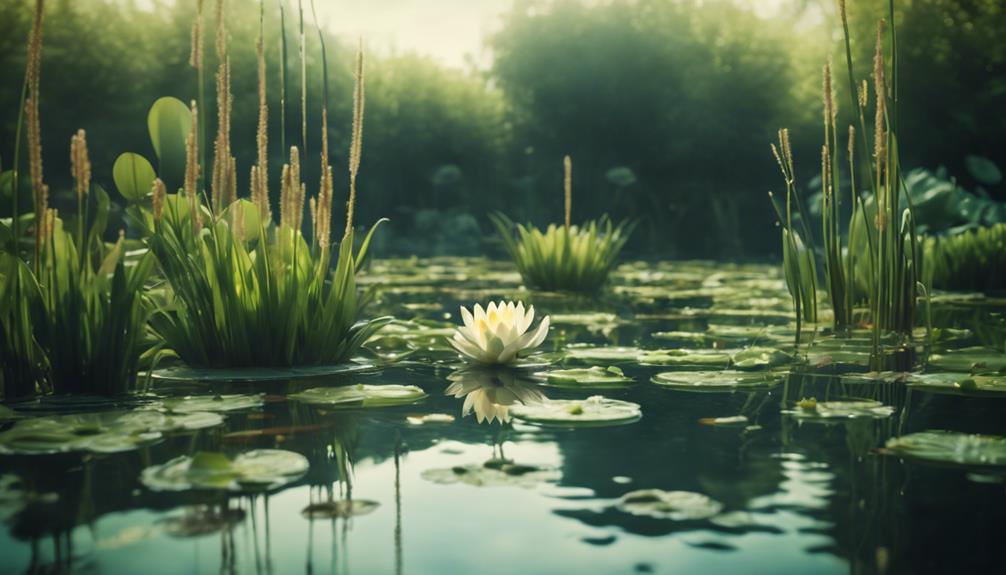
In a small pond, aquatic plants play a crucial role in reducing algae growth by outcompeting them for necessary nutrients and providing shade that limits sunlight exposure.
As you consider ways to manage algae growth in your pond, crucial to understand is the importance of aquatic plants. By incorporating them into your pond's ecosystem, you'll be taking a significant step towards maintaining good water quality.
Aquatic plants offer several key benefits:
They compete with algae for nutrients, reducing the likelihood of algae blooms.
They provide shade, which can limit sunlight exposure and slow down algae growth.
They absorb excess nutrients, preventing them from fueling algae growth.
Covering approximately two-thirds of the water's surface with plants like water lilies can help reduce algae growth and maintain a balanced ecosystem.
Maintaining a Balanced Ecosystem
When maintaining a balanced ecosystem in your small pond, you'll want to focus on managing nutrient balance and preventing excess growth.
By doing so, you'll create an environment where aquatic plants can thrive, outcompeting algae for resources.
Nutrient Balance Management
You can promote a balanced ecosystem in your small pond by managing the nutrient balance, which involves maintaining ideal levels of essential nutrients like nitrogen, phosphorus, and potassium.
This balance is vital, as excessive levels of these nutrients can lead to excessive algae growth.
To achieve perfect nutrient balance, you should:
- Monitor and adjust fertilizer applications to avoid over-fertilization, which can disrupt the nutrient balance and promote algae growth.
- Guarantee adequate oxygen levels in the water, as low oxygen levels can contribute to an imbalance in the ecosystem.
- Implement regular water testing to detect any nutrient imbalances early on, allowing you to take corrective action before they lead to excessive algae growth.
- Consider using natural or organic fertilizers, which tend to release nutrients more slowly and are less likely to cause sudden spikes in nutrient levels.
Preventing Excess Growth
By adopting these strategies to manage nutrient balance, you've taken the first step toward preventing excess algae growth in your small pond, but maintaining a balanced ecosystem requires ongoing efforts to limit the factors that contribute to its proliferation.
To achieve this, reduce the amount of fertilizer applications around your pond, as excess nutrients can seep into the water and fuel algae growth. Additionally, verify you're not overfeeding your fish, as uneaten food can decompose and release nutrients that support algae growth.
Take proactive steps to maintain a healthy ecosystem by regularly monitoring water parameters, such as pH, ammonia, and nitrite levels. Regularly cleaning your pond and removing decaying plant matter can also help prevent the buildup of nutrients.
Identifying and Managing Algae Types
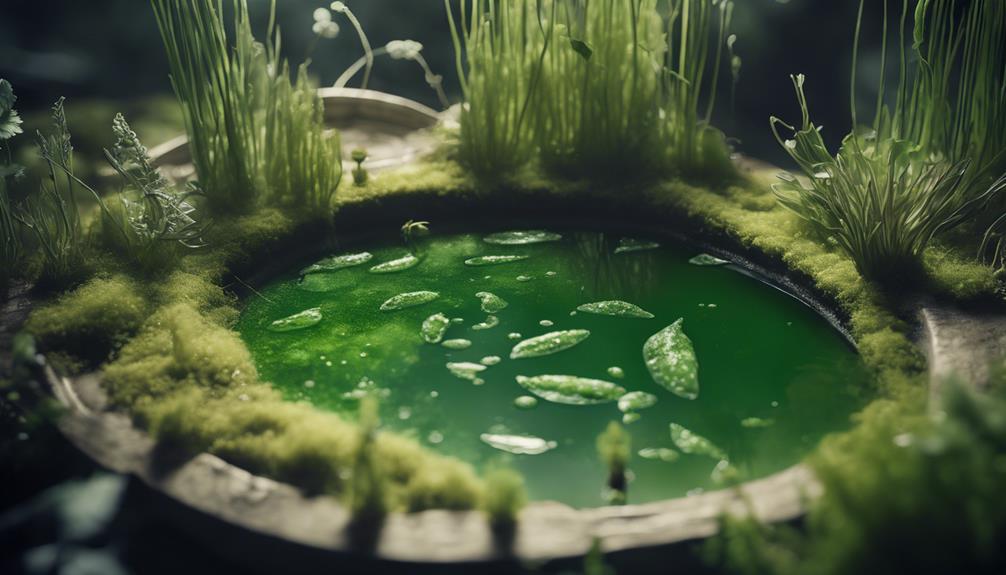
To effectively manage algae growth in small ponds, it's vital to first identify the specific type of algae present, as different species respond uniquely to various control methods and treatments.
If you're dealing with a green water issue, you might be looking at suspended algae, also known as 'pea soup.' This type of algae reproduces rapidly, turning your water cloudy and green, often due to excess nutrients, overfeeding fish, or poor filtration.
Consider adding a water test to determine the type of algae you're dealing with.
Filamentous algae: Multi-cellular, clear, mineral-enriched waters, good light penetration, and can be found on rocks and plants.
Planktonic algae: Single-celled, mobile, organic, enriched turbid waters.
Blue-green algae: Technically cyanobacteria, causing odors, surface scums, and toxins.
Suspended algae: Single-celled, rapid reproduction, turning water green and cloudy.
Harmful Effects of Algae Blooms
Algal blooms and mats can wreak havoc on small ponds, causing a cascade of detrimental effects that ripple throughout the entire ecosystem.
As you gaze out at your once-pristine pond, now turned green by an algae infestation, you may wonder what consequences this will have on the entire ecosystem.
Decaying algae can further deoxygenate the water, leading to a decrease in available oxygen for invertebrates, fish, and other pond life, which can cause stress and even death.
This can lead to a shift from a clear-water state to a turbid, algae-dominated state, making it difficult to reverse the damage.
Additionally, blue-green algae produce toxins that can poison wildlife, including fish, birds, and mammals, and even humans, if ingested or exposed to contaminated water.
If left unchecked, algal mats can block up inflows and outflows, causing water level fluctuations and altering the pond's hydrology, ultimately disrupting future growth and altering the delicate balance of your pond's ecosystem.
Frequently Asked Questions
How Do I Keep Algae Out of My Small Pond?
You'll keep algae out of your small pond by performing regular water changes, installing pond aeration, and removing organic matter. Introduce algae-eating creatures, like fish or snails, to create a balanced ecosystem and maintain a healthy, thriving environment.
What Causes Algae in Small Ponds?
You're basically a algae whisperer, inviting those pesky blooms with warm water temperatures, excess nutrients, and generous light exposure – it's like rolling out the green carpet for an algae party in your small pond!
What Is the Best Treatment for Algae in Ponds?
You'll find the best treatment for algae in ponds involves a combination of methods: algae prevention methods like regular cleaning, natural remedies like aquatic plants, chemical treatments like algaecides, and ultrasonic devices that disrupt algae growth.
What May Be Causing the Heavy Growth of Algae in the Pond?
You're wondering what's behind the heavy algae growth in your pond? It's likely due to a nutrient imbalance, excess sunlight, inadequate pond depth, or water stagnation, which create an ideal environment for algae to thrive.
Conclusion
As you gaze out at your once-pristine pond, now choked by a pea-soup haze of algae, remember that knowledge is power.
By grasping the fundamental causes of this aquatic affliction, you can banish the blooms and restore your pond's crystalline clarity.
With a balanced ecosystem and proactive maintenance, your pond will flourish, its waters sparkling like a gemstone in the sunlight, teeming with life and free from the algae's suffocating grip.

